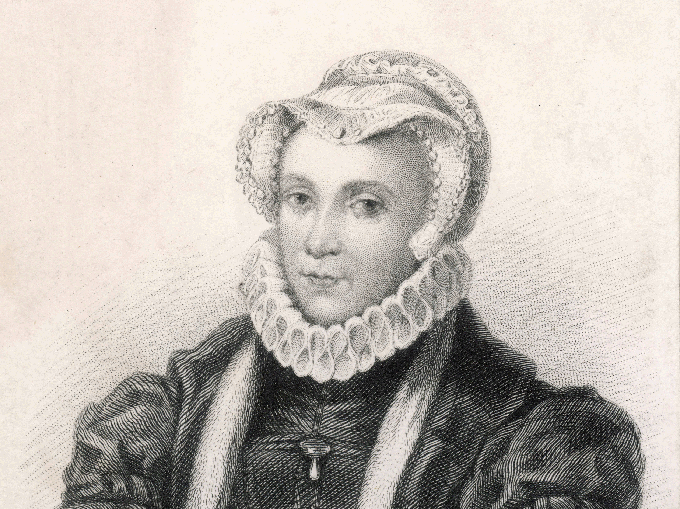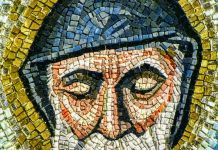Together with Tudor Times we profile a different figure every month. Here, Melita Thomas tackles Lady Margaret Douglas, who features in the latest issue of BRITAIN.
Lady Margaret Douglas lived an incident-packed life. She experienced almost everything that life as a member of the royal family could throw at her – marriage to a man she had only met a few days before the wedding, imprisonment in the Tower of London, the assassination of her husband and the murder of her son in the most notorious crime of the 16th century. Yet she managed to die in her bed.
Margaret’s mother was Margaret Tudor, Dowager Queen of Scots and her father was Archibald Douglas, Earl of Angus. She was born in England in October 1515 after her mother was forced to flee across the border to her brother, Henry VIII’s realm, although they soon returned to Scotland.
In 1528, following an acrimonious annulment between her parents, and irreconcilable differences between her father and her half-brother, James V, Margaret and Angus were exiled to England, where she spent the rest of her life.
Henry VIII became fond of his niece, and, for the most part, treated her kindly with gifts of clothes, money for ‘disport’, and positions as lady-in waiting to his daughter, Mary, then to his second wife, Anne Boleyn.
While Margaret served Queen Anne from 1533 to 1536, she was a member of a circle of courtiers who frittered away their hours in gambling, dancing, singing and writing poetry. Amongst them was an attractive young man, Lord Thomas Howard. He and Margaret fell in love and exchanged gifts, kisses and promises of marriage.
When Anne Boleyn was suddenly arrested, tried and executed, the story of Margaret’s betrothal came out and the king was incandescent with rage. Margaret and Thomas were clapped in the Tower of London, and a hasty law was passed, making it treason to marry into the royal family without permission. The two were held in prison until October 1537, when Lord Thomas died before his death sentence could be carried out.
Margaret was forgiven and from 1539 to 1543 served Henry’s three later queens, Anne of Cleves, Catherine Howard and Katherine Parr, appearing at court occasions, and being treated almost as a princess. It was not until June 1544, when she was nearly 29, that Henry decided on a husband for Margaret.
He chose Matthew Stuart, Earl of Lennox, a Scot who had lived in France for many years, following the murder of his father. Lennox had returned to Scotland in 1543 where he became embroiled in the politics around the Regency government. He defected to the pro-English party, represented by the Earl of Angus, Margaret’s father and in a deal to safeguard his loyalty, Margaret was offered as his bride.
They were married in St James’ Palace, London, in the presence of the King and Queen. Her uncle settled a huge swathe of land in northern England on the couple, who quickly became devoted to each other.
During the next few years, Lennox was often away, fighting in the Anglo-Scottish ‘War of the Rough Wooing’ while Margaret divided her time between Temple Newsam, near Leeds, and the court. She gave birth to eight children but only Henry, Lord Darnley, and Lord Charles Stuart, survived infancy.
On the accession to the throne of Margaret’s much-loved cousin, Mary, she became chief lady-in-waiting, often being given precedence over the queen’s half-sister, the Lady Elizabeth. Mary considered making Margaret her heir, but this was not politically feasible. Margaret’s pretensions to the succession did not endear her to Elizabeth, and, when the latter became queen in 1558, it was made clear that Margaret would not be welcome at court.
In 1561 with the return of Margaret’s widowed niece, Mary, Queen of Scots from France, intending to rule in person, Margaret and Lennox hoped that their 16-year-old son, Lord Darnley, might make a suitable match for the young queen. Elizabeth I was livid when she heard of their plans and dispatched Lennox to the Tower, and Margaret to house arrest.
Three years later, Margaret and Lennox tried again, persuading Elizabeth to let Lennox travel to Scotland to plead for his lands to be returned, with the help of his heir, Darnley. Elizabeth held Margaret as surety that Darnley would not marry Queen Mary, but once in Scotland, Darnley pursued a vigorous courtship, culminating in marriage to Mary in July 1565.
Incensed, Elizabeth sent Margaret to the Tower where she remained for two years until the terrible news came that her cherished son had been assassinated, and that his widow had swiftly married the prime suspect. Even the somewhat stony Elizabeth pitied her cousin. Margaret was released, and Lennox returned from Scotland.
By 1568, Queen Mary had been deposed, replaced by Margaret’s infant grandson, now James VI. When his Regent, Moray, was assassinated, Elizabeth permitted Lennox to take up the regency. Margaret and their younger son stayed in England, as hostages to ensure Lennox followed a pro-English policy.
Within months Lennox had been killed in a skirmish outside Stirling. Fearing for Margaret’s health on the loss of her beloved husband, Elizabeth told her personally. Margaret was overcome with grief.
In 1573, Margaret and her friend, Bess of Hardwick, Countess of Shrewsbury, planned a marriage between Lord Charles Stuart and Bess’s daughter, Elizabeth Cavendish. Charles was Queen Elizabeth’s nearest English-born male relative. To neglect to mention their plans to her, especially in view of the queen’s wrath over the Darnley marriage, seems to indicate the triumph of hope over experience.
Nevertheless, the plans advanced, and in 1574, Charles and Elizabeth Cavendish were hastily married. The queen could hardly believe her ears. Margaret was returned to the Tower, to while away some months until Elizabeth was persuaded that there was no plot to free Queen Mary. Charles and his wife were parted, although not before she had conceived. In 1575, Margaret’s second grandchild, Lady Arbella Stuart, was born.
Lord Charles died in 1577, aged only 21. Margaret had now outlived all her children, had never seen her grandson, and had only the solace of Arbella, who lived with her at Hackney, in London.
In March 1578, Margaret died. She was buried in Westminster Abbey where, later, a splendid monument was raised to her by her grandson, James VI of Scotland, who had finally inherited Elizabeth’s crown.
In the words of Shakespeare, it may be said of Lady Margaret that “Thou shalt get Kings, though thou be none.” HM Queen Elizabeth II is her 12 times great-granddaughter, making Margaret the ultimate Tudor success story.






 © 2024
© 2024